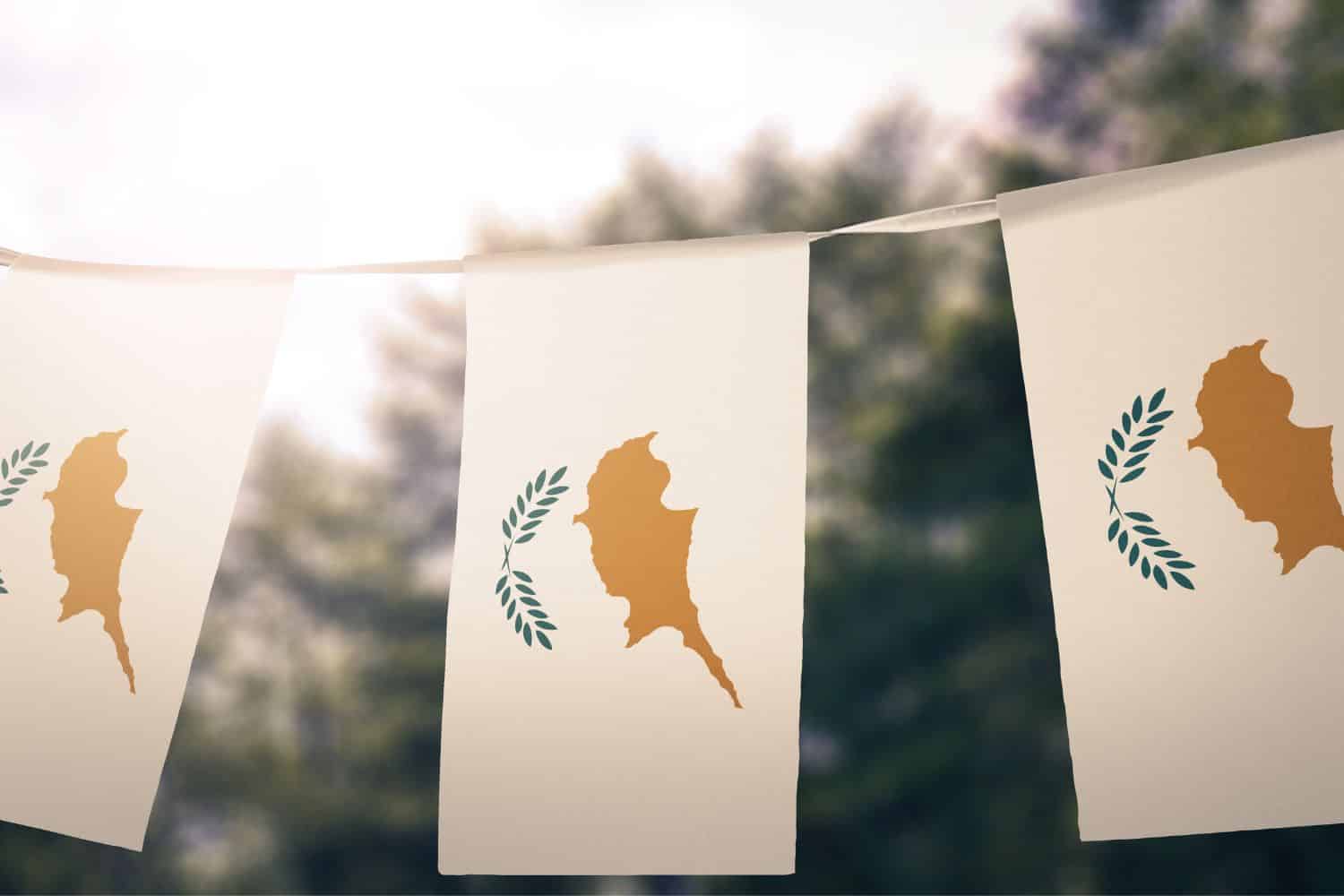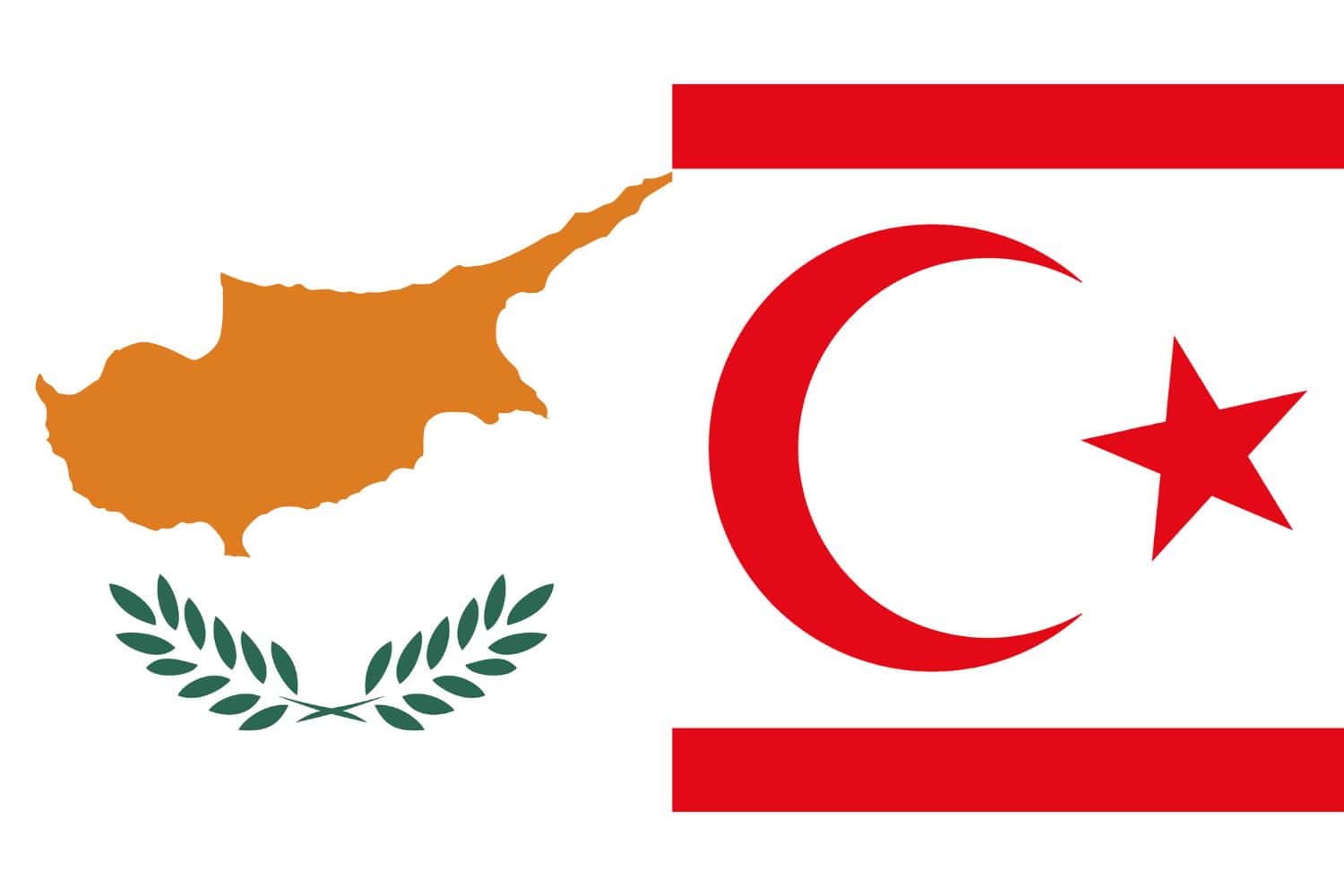Table of Contents
The Cypriot flag, also referred to as the flag of Cyprus, embodies a profound essence of the country’s history and heritage, encapsulating the Cypriot identity with pride. With its distinct hues and symbolic elements, the flag serves as a unifying emblem, resonating deeply with the people of Cyprus. In this discourse, we shall delve into the captivating narrative of the Cyprus flag, elucidating its composition, historical context, and the significance imbued within its components.
The Cyprus flag comprises a background of white, featuring a depiction of the island’s map in orange, with olive branches adorning each side of the map. This composition holds profound symbolic meaning, reflecting the island’s geography, aspirations, and historical journey.
Cyprus Flag: Design and Symbolism
- The flag of Cyprus features a white background with an orange map of the island at its center.
- Flanking the map on either side are two olive branches.
- The white background symbolizes peace and unity, embodying the nation’s pursuit of harmony and coexistence.
- The orange map represents the island of Cyprus itself, signifying the geographical and territorial integrity of the nation.
- The olive branches epitomize peace, prosperity, and reconciliation, serving as enduring symbols of tranquility and hope for the Cypriot people.
- Together, these elements encapsulate the essence of Cyprus, its aspirations for peace, and its rich cultural heritage, resonating deeply with its citizens and reflecting the nation’s journey through history.
Flag of Cyprus

The Cypriot flag consists of a white field with a depiction of the island’s map in orange at its center. Flanking the map on either side are two olive branches.
The white field symbolizes peace, unity, and the bright prospects for Cyprus. It embodies the nation’s pursuit of harmony and coexistence among its diverse communities.
The orange map represents the geographical integrity and sovereignty of Cyprus, encapsulating the essence of the island nation.
The olive branches on either side of the map symbolize peace, prosperity, and reconciliation. They reflect the Cypriot people’s enduring hope for tranquility and cooperation, despite the challenges they have faced.
Together, these elements form a poignant representation of Cyprus, its aspirations for peace, and its rich cultural heritage, resonating deeply with its citizens and reflecting the nation’s journey through history.
National Flag Etiquette and Protocol

Understanding and adhering to proper flag etiquette are fundamental to showing respect for the national symbol of Cyprus. Familiarize yourself with the protocols governing the usage, display, and handling of the Cypriot flag, particularly during significant national events and ceremonies. Below are essential guidelines to ensure the proper treatment of the flag:
- Careful Handling: Handle the flag with utmost care and reverence. Avoid allowing it to touch the ground or floor, and ensure it is held upright without dragging.
- Hoisting and Lowering: Raise the flag briskly and lower it ceremoniously. It is customary to hoist the flag at sunrise and lower it at sunset, following specific occasions or guidelines.
- Flag Orientation: When displaying the flag vertically, ensure the white field with the orange map is positioned on the top, with the olive branches flanking the sides. Ensure the flag is free to fly without entanglement or obstruction.
- Half-Mast Display: Lowering the flag to half-mast signifies mourning or respect. This gesture is observed on designated days of remembrance or as directed by authorities to honor national tragedies or the passing of prominent figures.
- Flag Retirement: When a flag becomes damaged, torn, or worn out, it should be retired with dignity. Follow appropriate guidelines and local regulations for the respectful retirement of the flag, which may include a solemn burning ceremony.
- Flag Size and Placement: Ensure the size of the displayed flag is proportionate to the flagpole or display area. Consult local authorities or guidelines for specific rules regarding flag size and placement.
- Respectful Disposal: If burning is not feasible, dispose of the flag in a respectful manner. Options include burial or entrusting it to authorized organizations specialized in flag disposal.
By observing these protocols and guidelines, you contribute to upholding the honor and dignity of the Cypriot flag, reflecting the values and pride of the nation.
Interesting Facts and Trivia

Embark on a journey of intriguing facts and lesser-known trivia about the flag of Cyprus. Uncover unique features within the flag’s design that hold hidden symbolism. Explore stories of notable incidents or events involving the flag that have left a lasting impact on the nation’s history and identity.
Rich Tapestry of History
- 1960: The modern flag was adopted upon Cyprus gaining independence from British colonial rule, symbolizing the nation’s sovereignty and unity.
- 1974: Following a coup and subsequent Turkish invasion, Cyprus underwent division, with the northern part proclaiming independence as the Turkish Republic of Northern Cyprus, leading to the adoption of a separate flag.
- 1983: The Turkish Republic of Northern Cyprus introduced its own flag, distinct from the original Cypriot flag, reflecting the division on the island.
- 2004: With Cyprus joining the European Union, the flag of Cyprus became a symbol of the nation’s membership in the EU, representing its commitment to European values and cooperation.
These historical facts underscore significant moments in the history of Cyprus’s flag, illustrating its role in shaping the country’s national identity and symbolizing its struggles and achievements over time.
Flag-Related Symbols and Emblems
A flag is not the sole representation of a nation’s identity. Explore additional national symbols and emblems closely associated with Cyprus, understanding their significance and how they relate to the flag. Delve into their historical and cultural roots, further enriching your understanding of the country’s heritage.
Symbolisms of the Cypriot Flag
The flag of Cyprus embodies several symbolic elements that represent the nation’s history, values, and aspirations. Here are the symbolisms of the Cypriot flag presented in itemized form:
- White Color: Signifies peace, harmony, and the aspiration for a unified Cyprus, free from conflict and division.
- Red Color: Represents the struggle for independence and sovereignty, as well as the courage and resilience of the Cypriot people throughout history.
- Green Olive Branches: Symbolize peace, reconciliation, and hope for the future, emphasizing Cyprus’s commitment to peaceful coexistence and diplomacy.
- Map of Cyprus: Depicts the entirety of the island, emphasizing the nation’s territorial integrity and sovereignty over its land.
- Historical Legacy: The flag symbolizes Cyprus’s rich history, including its fight for independence, struggle against division, and pursuit of peace and unity.
- National Identity: Serving as a unifying symbol, the flag reminds Cypriots of their shared heritage and cultural identity, transcending ethnic and political divides.
- National Aspirations: Through its design and elements, the flag embodies the aspirations and values of the Cypriot nation, including independence, peace, unity, and prosperity.
These symbolisms in the flag contribute to Cyprus’s sense of identity and pride, reflecting its historical journey and cultural significance.
Flags of Similar Countries or Regions
Exploring the flags of neighboring countries or regions can offer intriguing insights into their cultural and historical connections. By comparing and contrasting flags, one can uncover shared influences, distinctive identities, and symbolic meanings. Consider the following comparisons between the flag of Cyprus and those of its neighboring countries or regions:
Cypriot Flag vs Greek Flag

Similarity: Both flags prominently feature the color blue, symbolizing the sea and the sky.
Difference: The Cypriot flag depicts a map of the island in yellow, symbolizing unity, while the Greek flag consists of nine horizontal stripes, alternating between blue and white, representing the nine syllables of the Greek phrase “Freedom or Death.”
Cypriot Flag vs Turkish Cypriot Flag

Similarity: Both flags incorporate the color white in their design.
Difference: The Cypriot flag features two olive branches in white, symbolizing peace and reconciliation, while the Turkish Cypriot flag includes a white crescent moon and star on a red background, representing the Turkish Cypriot identity.
Cypriot Flag vs British Flag

Similarity: Both flags include the color red in their design.
Difference: The Cypriot flag features a copper-colored map of the island on a white field, symbolizing the nation’s heritage and prosperity, while the British flag, known as the Union Jack, consists of red and white crosses on a blue background, representing the union of England, Scotland, and Ireland.
Cypriot Flag vs Egyptian Flag

Similarity: Both flags incorporate the colors red, white, and green.
Difference: The Cypriot flag features two olive branches in green on a white field, symbolizing peace and prosperity, while the Egyptian flag consists of three horizontal stripes; red on top, white in the middle, and black at the bottom, with a golden eagle of Saladin in the center white stripe, symbolizing Egypt’s struggle for independence and sovereignty.
Cypriot Flag vs Lebanese Flag

Similarity: Both flags incorporate the color red in their design.
Difference: The Cypriot flag features two olive branches in white on a yellow field, symbolizing peace and prosperity, while the Lebanese flag consists of two horizontal stripes; red on top and white at the bottom, with a green cedar tree centered on the red stripe, symbolizing Lebanon’s resilience and unity.
Frequently Asked Questions (FAQs)
Explore answers to common questions related to Cyprus flag picture. From its historical significance to the symbolism behind its elements, find concise and informative responses that address inquiries frequently posed by those interested in Cyprus’s flag.
What do the colors on the flag of Cyprus represent?
The white color symbolizes peace and unity, while the copper-yellow color represents the mineral wealth of Cyprus.
What is the significance of the map depicted on the Cypriot flag?
The map represents the entire island of Cyprus, highlighting the country’s sovereignty and territorial integrity.
How many olive branches are depicted on the flag of Cyprus, and what do they symbolize?
Two olive branches are depicted on the Cypriot flag, symbolizing peace and reconciliation.
When was the current flag of Cyprus adopted, and what historical event does it commemorate?
The current flag of Cyprus was adopted on August 16, 1960, upon Cyprus gaining independence from British colonial rule. It commemorates the nation’s sovereignty and unity.
What is the shape of the map depicted on the flag of Cyprus, and what does it signify?
The map is in the shape of the entire island of Cyprus, symbolizing the country’s territorial integrity and sovereignty over the entire landmass.
Which specific shade of yellow is used on the Cypriot flag, and why?
The color used is copper-yellow, representing the mineral wealth of Cyprus, particularly its historical association with copper mining.
How does the flag of Cyprus differ from that of its Turkish Cypriot counterpart?
The Cypriot flag features a map of the entire island and two olive branches on a white field, while the Turkish Cypriot flag includes a white crescent moon and star on a red background.
What is the historical significance of the olive branches on the Cypriot flag?
Olive branches have been used historically as symbols of peace and reconciliation, reflecting Cyprus’s aspiration for harmony and unity.
